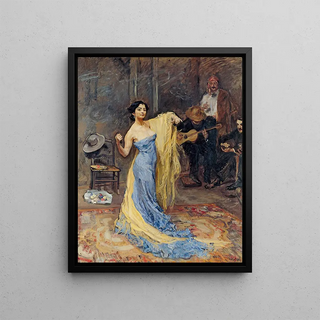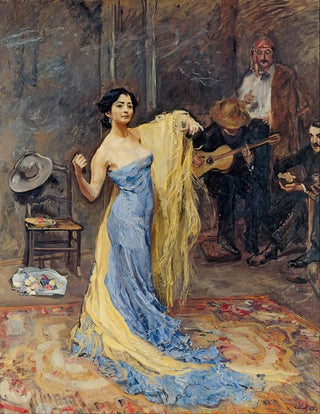Art print | Portrait of the dancer Marietta di Rigardo - Max Slevogt


View from behind

Frame (optional)
Portrait of the dancer Marietta di Rigardo - Max Slevogt – Captivating introduction
In the world of art, some works manage to capture the essence of a moment, an emotion, a life. The "Portrait of the dancer Marietta di Rigardo" by Max Slevogt is one of those iconic pieces that transcend the simple frame of a canvas to immerse the viewer in the vibrant universe of dance and performance. This painting, both intimate and dynamic, reveals a dancer whose grace and passion seem almost tangible. The light plays on the contours of her face, revealing ephemeral beauty, while her gesture evokes the fluidity of movement. Contemplating this work, one feels the energy of a frozen moment in time, an invitation to explore the depths of art and life.
Style and uniqueness of the work
Slevogt's style is distinguished by a bold and innovative approach, blending impressionism and symbolist influences. In this portrait, the vibrant color palette and vigorous brushstrokes create an atmosphere that is both warm and captivating. The dancer, Marietta di Rigardo, is depicted in a pose that suggests movement, as if she is about to leap out of the canvas. The delicate details of her attire, as well as the blurred background, reinforce this impression of dynamism. Slevogt succeeds in capturing not only the appearance of his subject but also the emotion emanating from her presence. This painting is a celebration of dance, but also a reflection on the fleeting beauty of living art, a duality that Slevogt masters with brilliance.
The artist and his influence
Max Slevogt, a major figure in German art of the early 20th century, established himself through his unique style and artistic vision. Influenced by the great masters of his time, he developed a personal approach that allowed him to stand out. Slevogt often explored themes related to nature, music, and dance, demonstrating his deep interest in the performing arts. His ability to translate life and movement onto canvas has inspired many contemporary artists and

Matte finish

View from behind

Frame (optional)
Portrait of the dancer Marietta di Rigardo - Max Slevogt – Captivating introduction
In the world of art, some works manage to capture the essence of a moment, an emotion, a life. The "Portrait of the dancer Marietta di Rigardo" by Max Slevogt is one of those iconic pieces that transcend the simple frame of a canvas to immerse the viewer in the vibrant universe of dance and performance. This painting, both intimate and dynamic, reveals a dancer whose grace and passion seem almost tangible. The light plays on the contours of her face, revealing ephemeral beauty, while her gesture evokes the fluidity of movement. Contemplating this work, one feels the energy of a frozen moment in time, an invitation to explore the depths of art and life.
Style and uniqueness of the work
Slevogt's style is distinguished by a bold and innovative approach, blending impressionism and symbolist influences. In this portrait, the vibrant color palette and vigorous brushstrokes create an atmosphere that is both warm and captivating. The dancer, Marietta di Rigardo, is depicted in a pose that suggests movement, as if she is about to leap out of the canvas. The delicate details of her attire, as well as the blurred background, reinforce this impression of dynamism. Slevogt succeeds in capturing not only the appearance of his subject but also the emotion emanating from her presence. This painting is a celebration of dance, but also a reflection on the fleeting beauty of living art, a duality that Slevogt masters with brilliance.
The artist and his influence
Max Slevogt, a major figure in German art of the early 20th century, established himself through his unique style and artistic vision. Influenced by the great masters of his time, he developed a personal approach that allowed him to stand out. Slevogt often explored themes related to nature, music, and dance, demonstrating his deep interest in the performing arts. His ability to translate life and movement onto canvas has inspired many contemporary artists and






